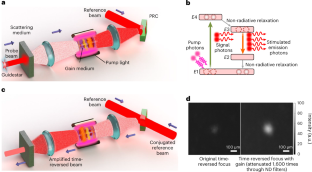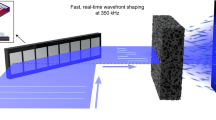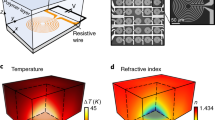Abstract
Wavefront shaping (WFS) is emerging as a promising tool for controlling and focusing light in complex scattering media. The shaping system’s speed, the energy gain of the corrected wavefronts and the control degrees of freedom are the most important metrics for WFS, especially for highly scattering and dynamic samples. Despite recent advances, current methods suffer from trade-offs that limit satisfactory performance to only one or two of these metrics. Here we report a WFS technique that simultaneously achieves high speed, high energy gain and high control degrees of freedom. By combining photorefractive crystal-based analogue optical phase conjugation and stimulated emission light amplification, our technique achieves an energy gain approaching unity; that is, more than three orders of magnitude larger than conventional analogue optical phase conjugation. The response time of ~10 μs with about 106 control modes corresponds to an average mode time of about 0.01 ns per mode, which is more than 50 times quicker than some of the fastest WFS systems so far. We anticipate that this technique will be instrumental in overcoming the optical diffusion limit in photonics and translate WFS techniques to real-world applications.
This is a preview of subscription content, access via your institution
Access options
Access Nature and 54 other Nature Portfolio journals
Get Nature+, our best-value online-access subscription
$29.99 / 30 days
cancel any time
Subscribe to this journal
Receive 12 print issues and online access
$209.00 per year
only $17.42 per issue
Buy this article
- Purchase on Springer Link
- Instant access to full article PDF
Prices may be subject to local taxes which are calculated during checkout





Similar content being viewed by others
Data availability
All data that support the findings of this study are available within the article and Supplementary Information, or available from the corresponding author on reasonable request.
Code availability
The codes used in this study are available from the corresponding author on reasonable request.
References
Vellekoop, I. M. & Mosk, A. P. Focusing coherent light through opaque strongly scattering media. Opt. Lett. 32, 2309–2311 (2007).
Mosk, A. P., Lagendijk, A., Lerosey, G. & Fink, M. Controlling waves in space and time for imaging and focusing in complex media. Nat. Photon. 6, 283–292 (2012).
Wang, Y. M., Judkewitz, B., DiMarzio, C. A. & Yang, C. Deep-tissue focal fluorescence imaging with digitally time-reversed ultrasound-encoded light. Nat. Commun. 3, 928 (2012).
Akbulut, D., Huisman, T. J., van Putten, E. G., Vos, W. L. & Mosk, A. P. Focusing light through random photonic media by binary amplitude modulation. Opt. Express 19, 4017–4029 (2011).
Katz, O., Small, E., Bromberg, Y. & Silberberg, Y. Focusing and compression of ultrashort pulses through scattering media. Nat. Photon. 5, 372–377 (2011).
Conkey, D. B., Brown, A. N., Caravaca-Aguirre, A. M. & Piestun, R. Genetic algorithm optimization for focusing through turbid media in noisy environments. Opt. Express 20, 4840–4849 (2012).
Lai, P., Wang, L., Tay, J. W. & Wang, L. V. Photoacoustically guided wavefront shaping for enhanced optical focusing in scattering media. Nat. Photon. 9, 126–132 (2015).
Blochet, B., Bourdieu, L. & Gigan, S. Focusing light through dynamical samples using fast continuous wavefront optimization. Opt. Lett. 42, 4994–4997 (2017).
Frostig, H. et al. Focusing light by wavefront shaping through disorder and nonlinearity. Optica 4, 1073–1079 (2017).
Jang, M. et al. Wavefront shaping with disorder-engineered metasurfaces. Nat. Photon. 12, 84–90 (2018).
Nixon, M. et al. Real-time wavefront shaping through scattering media by all-optical feedback. Nat. Photon. 7, 919–924 (2013).
Popoff, S. M. et al. Measuring the transmission matrix in optics: an approach to the study and control of light propagation in disordered media. Phys. Rev. Lett. 104, 100601 (2010).
Kim, M. et al. Maximal energy transport through disordered media with the implementation of transmission eigenchannels. Nat. Photon. 6, 581–585 (2012).
Boniface, A., Mounaix, M., Blochet, B., Piestun, R. & Gigan, S. Transmission-matrix-based point-spread-function engineering through a complex medium. Optica 4, 54–59 (2017).
Mounaix, M., de Aguiar, H. B. & Gigan, S. Temporal recompression through a scattering medium via a broadband transmission matrix. Optica 4, 1289–1292 (2017).
Yılmaz, H., Hsu, C. W., Yamilov, A. & Cao, H. Transverse localization of transmission eigenchannels. Nat. Photon. 13, 352–358 (2019).
Mounaix, M. et al. Spatiotemporal coherent control of light through a multiple scattering medium with the multispectral transmission matrix. Phys. Rev. Lett. 116, 253901 (2016).
Conkey, D. B., Caravaca-Aguirre, A. M. & Piestun, R. High-speed scattering medium characterization with application to focusing light through turbid media. Opt. Express 20, 1733–1740 (2012).
Li, S., Horsley, S. A. R., Tyc, T., Čižmár, T. & Phillips, D. B. Memory effect assisted imaging through multimode optical fibres. Nat. Commun. 12, 3751 (2021).
Cui, M. & Yang, C. Implementation of a digital optical phase conjugation system and its application to study the robustness of turbidity suppression by phase conjugation. Opt. Express 18, 3444–3455 (2010).
Hsieh, C.-L., Pu, Y., Grange, R. & Psaltis, D. Digital phase conjugation of second harmonic radiation emitted by nanoparticles in turbid media. Opt. Express 18, 12283–12290 (2010).
Liu, Y., Ma, C., Shen, Y., Shi, J. & Wang, L. V. Focusing light inside dynamic scattering media with millisecond digital optical phase conjugation. Optica 4, 280–288 (2017).
Cheng, Z., Yang, J. & Wang, L. V. Intelligently optimized digital optical phase conjugation with particle swarm optimization. Opt. Lett. 45, 431–434 (2020).
Ruan, H. et al. Deep tissue optical focusing and optogenetic modulation with time-reversed ultrasonically encoded light. Sci. Adv. 3, eaao5520 (2017).
Ma, C., Xu, X., Liu, Y. & Wang, L. V. Time-reversed adapted-perturbation (TRAP) optical focusing onto dynamic objects inside scattering media. Nat. Photon. 8, 931–936 (2014).
Feldkhun, D., Tzang, O., Wagner, K. H. & Piestun, R. Focusing and scanning through scattering media in microseconds. Optica 6, 72–75 (2019).
Wang, D. et al. Focusing through dynamic tissue with millisecond digital optical phase conjugation. Optica 2, 728–735 (2015).
Cheng, Z. & Wang, L. V. Focusing light into scattering media with ultrasound-induced field perturbation. Light Sci. Appl. 10, 159 (2021).
Yaqoob, Z., Psaltis, D., Feld, M. S. & Yang, C. Optical phase conjugation for turbidity suppression in biological samples. Nat. Photon. 2, 110–115 (2008).
Xu, X., Liu, H. & Wang, L. V. Time-reversed ultrasonically encoded optical focusing into scattering media. Nat. Photon. 5, 154–157 (2011).
Liu, Y. et al. Optical focusing deep inside dynamic scattering media with near-infrared time-reversed ultrasonically encoded (TRUE) light. Nat. Commun. 6, 5904 (2015).
Tzang, O. et al. Wavefront shaping in complex media with a 350 kHz modulator via a 1D-to-2D transform. Nat. Photon. 13, 788–793 (2019).
Cheng, Z., Yang, J. & Wang, L. V. Dual-polarization analog optical phase conjugation for focusing light through scattering media. Appl. Phys. Lett. 114, 231104 (2019).
Wei, X. et al. Real-time frequency-encoded spatiotemporal focusing through scattering media using a programmable 2D ultrafine optical frequency comb. Sci. Adv. 6, aay1192 (2020).
Hariharan, P. Basics of Holography (Cambridge Univ. Press, 2002).
Klein, M. B. Beam coupling in undoped GaAs at 1.06 μm using the photorefractive effect. Opt. Lett. 9, 350–352 (1984).
Boyd, R. W. Nonlinear Optics (Academic, 2008).
Wang, L. V. & Wu, H. Biomedical Optics: Principles and Imaging (John Wiley and Sons, 2007).
Ruan, H., Xu, J. & Yang, C. Optical information transmission through complex scattering media with optical-channel-based intensity streaming. Nat. Commun. 12, 2411 (2021).
Kumar, J., Albanese, G., Steier, W. H. & Ziari, M. Enhanced two-beam mixing gain in photorefractive GaAs using alternating electric fields. Opt. Lett. 12, 120–122 (1987).
Klein, M. B., McCahon, S. W., Boggess, T. F. & Valley, G. C. High-accuracy, high-reflectivity phase conjugation at 1.06 μm by four-wave mixing in photorefractive gallium arsenide. J. Opt. Soc. Am. B 5, 2467–2472 (1988).
Horstmeyer, R., Ruan, H. & Yang, C. Guidestar-assisted wavefront-shaping methods for focusing light into biological tissue. Nat. Photon. 9, 563–571 (2015).
Fredell, M., Carver, G., Chanda, S., Locknar, S. & Johnson, R. Sub-Nanometer Band Pass Coatings for LIDAR and Astronomy 9612 (SPIE, 2015).
Acknowledgements
We appreciate J. Ballard’s close reading of the paper and M. Cronin-Golomb’s discussions on the photorefractive theory. This work was financially supported by US National Institutes of Health (NIH) grants R35 CA220436 (Outstanding Investigator Award) and R01 EB028277.
Author information
Authors and Affiliations
Contributions
Z.C. and L.V.W. designed the study. Z.C. built the experimental system and performed the experiments. C.L. explored the amplification of scattered light at the early stage of the project. A.K. and Y.Z. prepared the living animal samples and participated in the in vivo experiments. L.V.W supervised the project. All of the authors wrote and revised the manuscript.
Corresponding author
Ethics declarations
Competing interests
L.W. has a financial interest in Microphotoacoustics, Inc., CalPACT, LLC. and Union Photoacoustic Technologies, Ltd., which, however, did not support this work. The other authors declare no competing interests.
Peer review
Peer review information
Nature Photonics thanks Cheng Ma and the other, anonymous, reviewer(s) for their contribution to the peer review of this work.
Additional information
Publisher’s note Springer Nature remains neutral with regard to jurisdictional claims in published maps and institutional affiliations.
Supplementary information
Supplementary Information
Supplementary Notes 1–12, Figs. 1–11 and Table 1.
Rights and permissions
Springer Nature or its licensor (e.g. a society or other partner) holds exclusive rights to this article under a publishing agreement with the author(s) or other rightsholder(s); author self-archiving of the accepted manuscript version of this article is solely governed by the terms of such publishing agreement and applicable law.
About this article
Cite this article
Cheng, Z., Li, C., Khadria, A. et al. High-gain and high-speed wavefront shaping through scattering media. Nat. Photon. 17, 299–305 (2023). https://doi.org/10.1038/s41566-022-01142-4
Received:
Accepted:
Published:
Issue Date:
DOI: https://doi.org/10.1038/s41566-022-01142-4
This article is cited by
-
A mathematical model for simulating photoacoustic signal generation and propagation in biological tissues
Optical and Quantum Electronics (2024)



